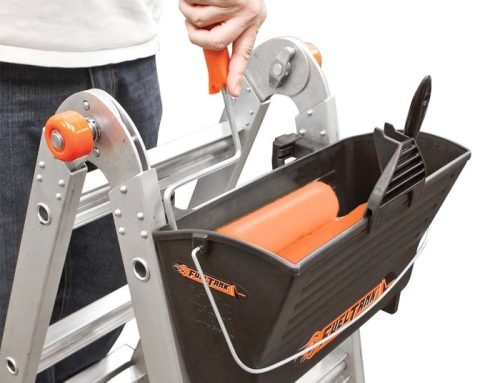Commercial and industrial racking is a feature of every warehouse, many DIY depots and the archive rooms of various institutions from The British Library to your local college or university. Accessing items held on these shelves is usually preceded, in the public sector at least, by a lengthy training session on the correct use of ladders. We're not saying this should be bypassed, far from it, but if the use of ladders by untrained people is a serious concern then looking at the type of ladder available might be worthwhile from a health and safety point of view.
Already a common sight in warehouses and tool centres, shelf ladders are similar to library ladders in that they can be slid along a rail (either with hooks fitted to the end of the stiles to secure it to the rail, or a crossbar which serves the same purpose depending on the design of the shelving itself) and don't need to be adjusted each time they are moved and used. While some large warehouses may use scissor lifts to access the very top shelves and podium steps to access those on a medium level, there is always place for a shelf ladder in the collection of height access equipment used in warehouses and depots, and the more options you have the more people can be working at the same time.
In less industrial applications, such as libraries, records offices and educational establishments the shelf ladder can be an invaluable bit of kit. For a long time a kik-stool was the primary height access equipment in these environments, but step ladders are not far behind. A step ladder is a little safer for a novice user than a straight ladder, but because they do not sit flush with a wall there is still an element of over-reaching and leaning which is not best practice, and often leads to accidents. Library ladders, which are similar in concept to a shelf ladder, are very expensive and can run into thousands of pounds for bespoke models. A shelf ladder that will provide access to normal height racking systems will cost less than £100 including VAT, so they are a much better option for those on a tight budget.
Of course, the racking systems these ladders are used with should be firmly fixed to the floor, as the racking itself provides a certain amount of stability to the ladder. Freestanding shelves won't provide any support and are unsuitable for use with a shelf ladder. On the subject of safety and stability, handrails are available with these ladders on one (£15) or both (£30) sides allowing the user to maintain contact with the ladder at all times. We would recommend at least one handrail is added for the safest set up.
The shelf ladders we sell are made by Lyte, a respected and well known British brand who have an enviable reputation in the industry. We offer several models between 5 and 13 treads long. The five tread model weighs in at just 3.5 kilos but can take a load of up to 175 kilos with Industrial use certification. For £79 including VAT this ladder provides a 1.2 metre reach with, of course, the option of hook fixings at the top and handrails on either side. Our tallest model offers a 3.17 metre reach and weighs a staggeringly low 8.6 kilos. It is also rated for Industrial use and can take an accordant load of 175 kilos, all for £153 including VAT. We offer free next day mainland delivery on most of our products.
Although these ladders are designed with function over aesthetics in mind they would also be suitable for accessing mezzanine floors or infrequently used storage spaces and can be left in place without getting in the way in many homes, so do bear these in mind when looking for domestic ladders too – you might be after a library ladder but you could save yourself some serious money by opting for a shelf ladder instead.






Leave A Comment
You must be logged in to post a comment.